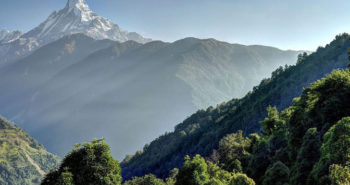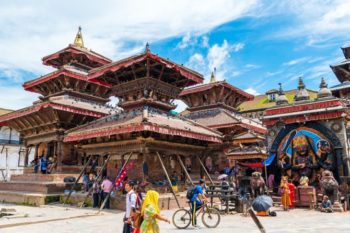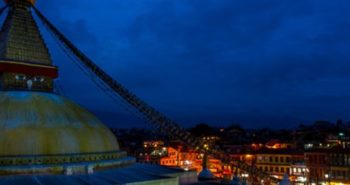Annapurna Circuit Trek Difficulty
Nepal = Mt. Everest Right?
While everyone knows about Mount Everest and the Everest Region of Nepal, there may be many who do not know much about the other trekking regions of the country. Even the most popular trekking area – Annapurna.
Taking its name from an ancient Sanskrit name for the goddess of plenty, Annapurna is not just one peak (Everest is one peak). Annapurna is, in fact, four peaks. Called Annapurna I, II, III, IV in order of height.
On the Annapurna Circuit, there is a vast range of diversity. Terraced hills; dense forests of Rhododendrons, pine, and bamboo; alpine glades; raging rivers; waterfalls; individual farmhouses, and bustling villages. As you ascend, there are monasteries, prayer flags, sheer cliffs, and drylands with hidden caves. There is also the possibility to see wildlife such as the Snow Leopard and Himalayan Thar.
Annapurna Circuit Trek – The Details
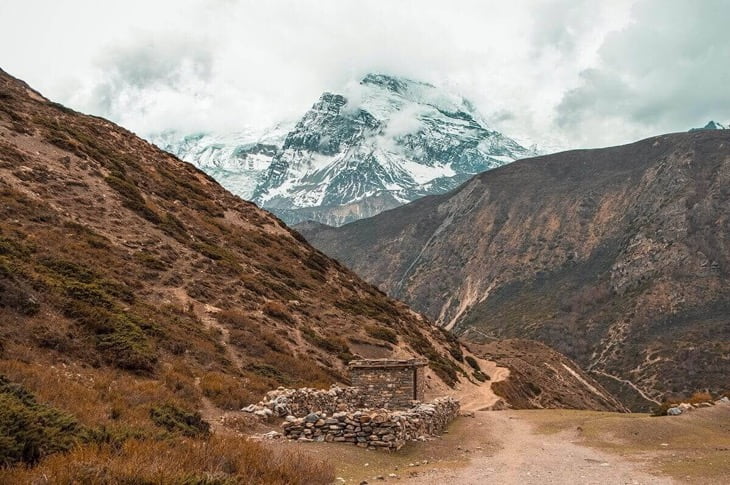
The Annapurna Circuit is a long trek, 18 trekking days
And a couple of days for driving from Kathmandu and on to Pokhara at the end of the trek.
It can be reduced to 14 trekking days
If you drive off-road from Kathmandu to Chame and take a flight from Jomsom
This is a demanding trek
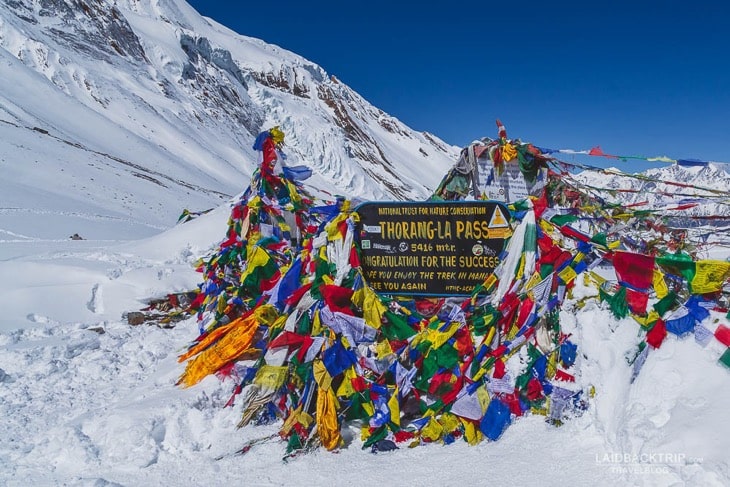
Starting at a lower elevation (Chame is at 2,710m), you slowly gain altitude, giving your body time to acclimatize. The highest point will be over the Thorong La pass at 5,416m.
While prior hiking experience is recommended, if you are pretty fit and confident this may not be mandatory. For those over 50 or with a sedentary lifestyle some fitness training before you come is recommended.
See here for our recommendations. But you can walk slowly. There are teahouses every 2 hours along the trail so you can stop and rest if it’s too exhausting. There is also an acclimatization day midway through the trek. We strongly advise you to take the opportunity of acclimatizing and resting before trekking on over 4,000 meters.
Total distance to walk
Depending on your itinerary (whether you drive or walk to Chame etc) the total trekking distance is 160km to 230km. This translates into 8-15km per day.
Trail Conditions
Prepare for the fact you will be walking uphill and downhill, and uphill and downhill If you have any leg or knee injuries please check with your doctor before leaving home
There may be snow when you cross the Thorong La Pass – which is one of the highest passes in the world. Carrying microspikes is recommended. If you are planning to do this trek in the winter, then bring crampons. In case of rain, usually in the summer/monsoon season only, come prepared!
Be sensible – hire a guide
Guides are not only invaluable in difficult or emergency situations, but they can also add depth and flavor to your trek. Your guide will explain the local people, culture and flora, and fauna. He can also book ahead for rooms (advisable in the peak seasons), be your best buddy, and be your lifeline if anything goes wrong.
Road Conditions
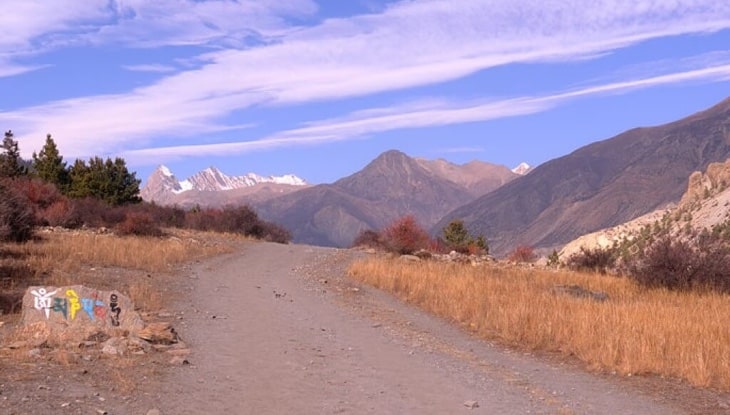
You will also be driving – so let’s look at the road conditions.
From Kathmandu to Beisahar the road is relatively good. Once you get out of the Kathmandu Valley and down as far as Mugling the road becomes quite smooth.
Up to this point, the road has followed the Trisuli River, with a steep drop, and single-track traffic at some points. You might also experience landslides in the monsoon season which will slow things down. After Mugling the road is good all the way to Beisahar.
If you are planning to reduce your trekking days and drive on to Chame, you will have an exciting off-road experience. You may not have encountered this type of road before. But don’t worry, the driver has!
Once you have crossed the Thorong La Pass, and crossed into Muktinath (an interesting cultural and pilgrim destination with an eternal flame and 108 water spouts), you can now get a local bus to Kagbeni or Jomson.
Every year the road improves but it was not that long ago that there was no road! You can still walk down to Kagbeni (spend the night if you have time as this is an interesting little walled village with a monastery and relaxing atmosphere). From here it is only 2 or 3 hours to Jomson.
An easy walk in the dry season (you will be walking along and through the river) but in the wet season, it might be better to go by road, whether on foot or by vehicle.
It is now possible to drive all the way from Muktinath to Pokhara (much reducing your trek and missing out on some of the most beautiful villages on the way). But if you chose this option, expect another off-road adventure!
Altitude Sickness
When talking about the difficulty of any trek in Nepal it is important to talk about altitude sickness. Most people can walk quite comfortably at sea level for 6 or 7 hours. But once you get up over 4,000m then those 6 or 7 hours can feel like an eternity!
On the Annapurna Circuit, you will be starting at a very low elevation and slowly gaining altitude. This will give you enough time to get used to the higher altitude.
Also, remember to add on 1 or 2 days for acclimatization. Don’t feel you are being ‘lazy’ or ‘unfit’ by building these days. They are important steps to trekking safely. You want to enjoy your trek. right?
Acclimatization
As we said, on this trek, if you start from the Manang side (which we recommend) the increase in altitude is more gradual. However, since you are reaching an altitude of 5,416m going over the Thorong La pass it is advisable to build on an acclimatization day.
We would suggest you do this in Manang town itself (3,519m). Not only will this give your body time to get used to the altitude and rest before the big push over the past, but there are also things to do in Manang!
You can take a short hike to Bhojo Gumpa (monastery) or to Gangapurna Lake. Or go a bit further and drop in at the Himalayan Rescue Associations office to learn more about Acute Mountain Sickness.
If this doesn’t convince you to slow down and acclimatize then perhaps these stories of people who didn’t make it over the Thorong La will.
As well as acclimatizing, it is important to:-
Stay hydrated.
That is the key to avoiding altitude sickness.
Trek slowly and steadily
There is no rush! It is not a race! Walking at a slower pace allows your body to acclimatize and allows you to enjoy nature.
Be aware
Take note of how your body is feeling. If you feel any sign of high altitude sickness, report it to your guide or your trekking buddies (if not trekking with a guide). Don’t try to ‘be a hero’.
Anyone can get altitude sickness – no matter how fit or young you are. In fact, is it more likely to be younger, fitter people who suffer? Why? Because they tend to power on and ascend too fast and not pay attention to their bodies.
What to do if you feel symptoms?
Rest. Drink water. If symptoms are not alleviated or
get worse. Go down. Descending to and sleeping at a lower altitude will help immensely. It could save your life.
How to Prepare for your Annapurna Circuit Trek
If you are young and fit (and be honest with yourself!), you may not require any special training before tackling the Annapurna Circuit. If you are not so young or so fit, then some cardio sessions at the gym and weekend hikes in your home country will be beneficial. But remember, this is the Himalayas and no walk in the park!
Here are some tips on pre-trek training:
Start walking!
Sounds simple right. But doing 30 minutes on the treadmill at home is not enough. Get out and walk. Build up to being able to walk 4 to 6 hours at a time comfortably.
Cardio
Remember that you will also be doing this at an altitude where there is less oxygen. So in addition, work on your cardio! Cycle, play football, play squash, do swimming. Squats and lunges will be excellent preparation for the ups and downs of the trail!
Different terrain
Your hometown might be pretty flat but the Himalayas aren’t. If you can, train on rocky terrain and loose shale, maybe some muddy footpaths! If its winter, walk in the snow – the deeper the better. Or walk in the sand along the beach. It’s important to strengthen your feet, ankles, and knees.
Rain
Don’t stop your pre-trek fitness routine just because it’s raining. Walking in different sorts of weather is great preparation!
Equipment
Wear a (full) backpack when hiking at home. What seems like a very light 5kg in your house will very soon feel much heavier when you have been walking for 5 hours! Test out how much you can comfortably carry. Practice using walking poles. You might look odd walking around your local park with poles but own the look! The practice will be well worth it. Buy your hiking boots or shoes well ahead of time. You need to wear them to break them in to avoid blisters on the actual trek. Good trekking socks and emergency blister pads etc are essentials!
Other Important Tips for Enjoying Your Trek
Walk slowly
There is no need to rush. It is not a race. Everyone has their own body’s walking pace. Besides, you are here to enjoy nature, take in the views and laugh with the locals. Leave the speed of walking to your gym.
Hire a porter
Unless you are an army soldier, you will not be used to carrying 10-15kg for upwards of 6 hours a day! Don’t spoil your adventure by exhausting yourself to save a few dollars. A porter will take the strain out of your trek and leave to you enjoy it. Besides, you are then helping the local economy by paying for the porter’s services.
Get a trekking pole
Don’t think these are for ‘old people. You will see many young people on the trail using them. Extremely helpful when crossing rivers, walking on slippery paths, etc.
Eat right and drink enough water
It’s possible during the first couple of days on the trek you feel tired and have a lack of appetite. This is just your body getting used to the unusual exercise.
But it is very important to eat and drink plenty of water. Even if you don’t really feel like it. Staying hydrated is the key to avoiding altitude sickness and to enjoying your trek. Eating well is important so that you have the energy to walk!
Know what to do when you have altitude sickness
Take note of how your body is feeling. If you feel any sign of high altitude sickness, report it to your guide or your trekking buddies (if not trekking with a guide). Anyone can get altitude sickness – no matter how to fit or young you are. Some of the signs of mild to moderate altitude sickness include:
- Difficulty sleeping.
- Dizziness or light-headedness.
- Fatigue.
- Headache.
- Loss of appetite.
- Nausea or vomiting.
- Rapid pulse (heart rate).
- Shortness of breath with exertion.
If you have any of these symptoms, slow down. Rest. Hydrate. If they continue, descent to a lower altitude. Sleep there and ascend again in the morning.
If your trekking buddy seems disorientated then take him/her down to a lower altitude immediately. Even if they insist they are okay. Altitude sickness affects you in such a way as you may not realize you have it.
So, Just How Difficult is the Annapurna Circuit Trek?
As we said, this is a demanding trek. But it can be made less so by being prepared. It can also be reduced from its traditional 18 days to 14 days if you drive into Chame at the start of the trek. And by a further 3 days if you drive out from Muktinath to Pokhara. But basically, you are here to trek, right?
Taking a porter and/or guide will certainly relieve both physical and mental stress and make your trek more enjoyable. But even if you go it alone, if you are properly prepared with the right level of fitness, right gear, and the right attitude you will really enjoy the Annapurna Circuit Trek!
